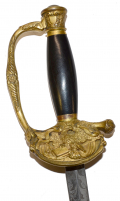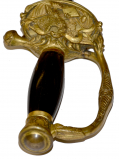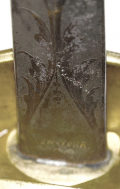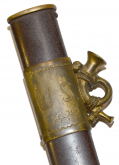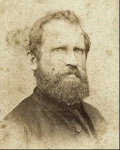site search
online catalog
1860 STAFF SWORD BY VIRGIL PRICE, NEW YORK, WITH FIGURAL SLING RINGS AND PATENT MOUNTING STUD

$1,950.00 SOLD
Originally $2,450.00
Quantity Available: None
Item Code: 766-1451
Virgil Price produced military swords during the Civil War and then shifted back into Masonic regalia and swords afterward. This seems to be a wartime 1860 staff sword that he repurposed and is a nice example of his blade etching and scabbard decoration using engraved and open-work figural mounts, and a key-stud mounting device for sword belt or baldric. The upper scabbard mount is engraved with a large block “U.S.” on the obverse and the figural sling rings are cast in the form of infantry hunting horns complete with cords. The blade is straight, 31-inches long, double edged and arris shaped, etched with floral scrolls and a blank cartouche for an owner’s name on one side and on the other with floral scrolls, a U.S. shield, stand of arms and an entwined U.S. with a glory of sunburst rays above and below.
The hilt has the general configuration of the 1860 staff sword, which transitioned into the 1872 “staff and line officer’s sword,” and has a standard foliate brass hilt with lantern shaped pommel with eagle on one side and blank shield on the other, but with a very rounded pommel cap and a very plain black grip. The counterguard is fixed on the obverse and folding on the reverse. The obverse is mounted with a separately cast high-relief eagle with scrolling banner in its beak, flags at left and right and clutching a book with one claw, certainly a bible and a fraternal or masonic motif. Hamilton, Ames Sword Company, attributes the use of separate castings mounted on the guard to an 1873 patent by Price, but the patent document cited does not seem to mention it. The reverse shows a crescent shaped area with some abrasion marks indicating an inscription may once have been there.
The hilt has some very nice gilt remaining and the scabbard body has a beautiful blue/plum color with just a little freckling toward the drag. Like the sling mounts, the drag has an openwork border, here consisting of foliate scrolls, a motif also engraved on the obverse of the boot. The brass scabbard mounts have a mellow, age patina. The blade etching is quite visible. The side with the U.S. motifs is a bit brighter than the other. Both have a mix of dull silver mixed with gray spotting, but the motifs are clear.
The openwork figural scabbard mounts seem typical of Price’s work. Thillmann illustrates two 1863 dated swords, one marked by Price and the other attributed to Emerson and Silver (U.S. Army Swords, pp. 346-7and 491-2.) Both use open work borders on the drags and serpents for the sling rings. Our example is etched “Virgil Price / New York” at one ricasso and the other bears a keystone stamped associated with Emerson and Silver, backing up some claims the two had a business relationship, though Price seems to have gotten blades for his own use from various sources. The 1863 presentation sword marked “Price / New York” shown by Thillmann, and the U.S. motifs on the blade and scabbard of this one, also point to a wartime origin. Price dissolved a partnership in the Masonic regalia business with N.O. Benjamin in August 1861, and they apparently entered the military sword business separately. Price filed for bankruptcy in 1868, in theory giving and end-date for the sword, but he seems to have remained in business and been also in partnership with his brother, William, all along. He continued to design fraternal and masonic swords and fittings, for which he took out a number of patents from 1867 to 1874.
One of Price’s patents was the key-shaped mounting stud to engage a plate on a sword belt or baldric, so it could be securely held but easily unfastened. This appears on the reverse of the upper ring mount of our sword. Thillmann’s Emerson and Silver attributed sword referenced above has one of these studs and bears an 1863 presentation. Illustrated with it is a belt rig with corresponding mounting plate marked, “Price’s Patent 1858.” And, while still in partnership with N. O. Benjamin as the “American Masonic Agency, the two men advertised “Price’s Patent Sword Hangings.” It turns out the patent was actually taken out by Jonathan Ball in 1858, but Price likely acquired the rights to it. He and Ball were both from Oneida County, NY, and Price was certainly aware of Ball’s patent, filing a modification of it using a removable chain in 1867.
Price’s later swords are not uncommon. His scarce wartime pieces show he was capable of some artistry as well as invention. [sr]
~~~~~~~~~~~~~~~~~~~~~~~~~~~~~~~~~~~
THIS ITEM, AS WITH ALL OTHER ITEMS AVAILABLE ON OUR WEB SITE,
MAY BE PURCHASED THROUGH OUR LAYAWAY PROGRAM.
CLICK HERE FOR OUR POLICIES AND TERMS.
THANK YOU!
Inquire About 1860 STAFF SWORD BY VIRGIL PRICE, NEW YORK, WITH FIGURAL SLING RINGS AND PATENT MOUNTING STUD
For inquiries, please email us at [email protected]
Most Popular
Historical Firearms Stolen From The National Civil War Museum In Harrisburg, Pa »
Theft From Gravesite Of Gen. John Reynolds »
Selection Of Unframed Prints By Don Troiani »
Fine Condition Brass Infantry Bugle Insignia »
British Imported, Confederate Used Bayonet »
Scarce New Model 1865 Sharps Still In Percussion Near Factory New »
featured item
IDENTIFIED CIVIL WAR US NAVY GROUP OF G.W. BROWN, PUBLISHED IN TIME-LIFE AND IN BLUEJACKETS, EX-STAMATELOS COLLECTION AND TEXAS CIVIL WAR MUSEUM
This a very scarce, extensive, identified Civil War U.S. Navy grouping, once in the renowned Stamatelos collection and more recently exhibited in the Texas Civil War Museum. It has also been published several times: most notably in Ron Field’s… (1179-262). Learn More »
site search
Upcoming Events
May 16 - 18: N-SSA Spring Nationals, Fort Shenandoah, Winchester, VA Learn More »






